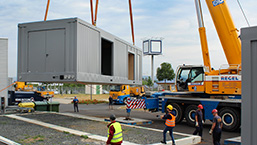Environmental simulation at ATESTEO
Environmental simulation: testing possibilities on the test bench
- High Temperature Operating Endurance (HTOE)
- Thermal behaviour
- Powered Thermal Cycling Endurance (PTCE)
- Low temperature test
- High Temperature High Humidity Endurance (HTHE)
ATESTEO is the leading specialist in drivetrain testing for combustion engines, electric drive systems, and hybrid drive systems. With many locations right where the automotive industry develops transmissions, ATESTEO offers drivetrain testing services close to the customer.
The simulation of environmental influences plays a large role during the development of automobiles. The earlier and more reliably components and assemblies can be tested on the test bench for their behaviour in terms of temperature, humidity, and shock, the more powerful and durable the drivetrain will be.
Drivetrain optimisation through environmental simulation testing
The drivetrain of a vehicle is subject to a multitude of environmental influences throughout its service life. These influences characterise performance and service life; thus, their impact on the environment as well. With methods of environmental simulation, ATESTEO tests the interaction between the drivetrain and its environment. The aim of environmental simulation is to discover relationships between causes and effects and to qualify parts or components for given environmental conditions.
The environmental simulation tests at ATESTEO are concerned with the effects of the environment on:
- Performance and functional behaviour of the test object.
- Long-term behaviour and service life of the test object.
- Reaction to the environment of the test object.
Environmental simulation on the test bench for all requirements
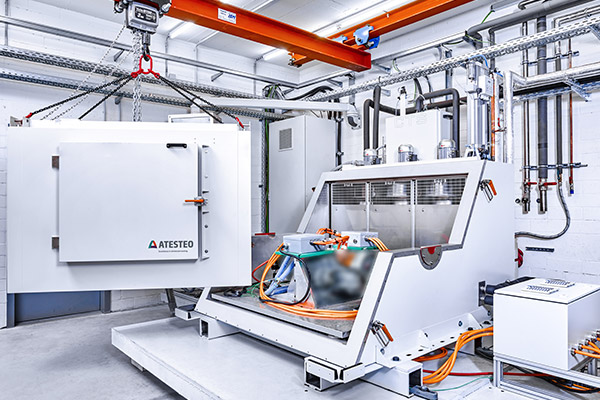
For optimally executing environmental simulation testing scenarios, ATESTEO offers various test benches; thus, the entire range of possibilities of testing. Depending on the specification, aim, test requirements, and type of drive unit, environmental simulation can be conducted at a fixed location or in mobile modules.
ATESTEO offers developers of electric drive units, hybrid drive units, and internal combustion engines innovative test technologies. In addition to the existing numerous classic stationary test benches for environmental simulation, modularly designed environmental simulation test benches compactly installed in mobile units provide new possibilities.
Innovative possibilities for environmental simulation especially for electric and hybrid drive units
The mobile environmental simulation test benches at ATESTEO score points with their modular, quickly changeable design. This means that not only drives with a combustion engine may be reliably tested for environmental influences, but also electric drive units and hybrid drive units may be thoroughly and precisely tested.
In a total of eight different configurations, with one or two load machines and an optional climate chamber, the test benches for environmental simulation at ATESTEO can be adapted at any time, anywhere, and rapidly to the respective testing requirements of the customer. During environmental simulation of electric drive units and hybrid drive units, a battery simulator is added to the respective configuration.
Download
You can find all information on environmental simulation on test benches at ATESTEO in our current brochure.
Environmental simulation testing for electric drive units, hybrid drive units, and internal combustion drives
Environmental simulation testing during the development of transmissions, powertrains, drivetrains, and drive units helps to recognise and eliminate sources of error at an early stage. This is especially true for electric drive units and hybrid drive units, because electronic components react differently to humidity, temperature, and shock. Testing environmental influences is crucial during the development of high-performance electric drive units and hybrid drive units.
The service life, range, and performance of the assemblies and components depend to a large degree on trouble-free operation under all kinds of environmental influences. For example, how do heat and dust in summer, sub-zero temperatures in winter, or salty air at the seaside affect the performance of the components? What do extreme temperature fluctuations do to the electronic drivetrain? How do components and assemblies react to environmental influences in terms of operational reliability?
This and much more is simulated over time, identified, and reliably documented in various environmental simulation tests at ATESTEO on the test bench. This is not just for the automotive industry, either. Whether on land, in water, or in the air, the tests during environmental simulation from ATESTEO can be carried out for all electric and electronic assemblies and components in vehicles.
Through great expertise in the field of e-mobility and through the modularity of the mobile test benches, ATESTEO fulfils the standards in testing High Temperature Operating Endurance (HTOE), Power Thermal Cycle Endurance (PTCE), and High Temperature Humidity Endurance (HTHE) during environmental simulations for electric drive units and hybrid drive units.
High Temperature Operating Endurance (HTOE)
Testing the thermal stress of the component owing to changes in temperature:
During high temperature endurance testing, ATESTEO simulates on the test bench the thermal load over time on assemblies and components during the life of the vehicle. This environmental simulation test serves to validate the quality and reliability of assemblies and components with respect to thermally induced patterns such as diffusion; that is, vibrational energy, electromigration, and oxidation of the materials.
High- and low-temperature storage (aging)
Testing the thermal stress on assemblies and components during storage and transport:
During high- and low-temperature storage tests, ATESTEO simulates on the test bench the load on the assembly or component under temperatures from -70° C to +180° C. This test demonstrates the resistance of the component to high and low temperatures during its storage or transport by truck, lorry, train, ship, or aircraft.
Incremental temperature test
Testing components in operation at various environmental temperatures:
During the incremental temperature test, ATESTEO tests on the test bench the operation of the assembly or component at various ambient temperatures. This validates the component against malfunction within a small interval of the range of operating temperatures.
Powered Thermal Cycling Endurance (PTCE)
Testing of the thermomechanical load on components owing to changes in temperature:
During the Powered Thermal Cycling Endurance (PTCE) test, ATESTEO tests on the test bench the effect of frequent changes in temperature on the component, such as, for example, its behaviour during rapid changes of the ambient temperature and humidity. The test validates the quality and reliability of the component with regard to thermomechanically induced defect patterns such as aging and cracking in soldered, glued, bonded, and welded joints as well as on seals and housings.
Low-temperature operation
Testing of the thermal stress on components at low temperatures:
During the low temperature operation test, ATESTEO investigates the behaviour of an assembly or component on the test bench under high stress owing to low temperatures. The functionality of the component is validated in real terms after a long time of being parked or while being driven for a long time at ultra-low temperatures.
Humid heat – High Temperature Humidity Endurance (HTHE)
Testing of the stress on components caused by humid heat and frost:
During the High Temperature Humidity Endurance (HTHE) test, ATESTEO simulates on the test bench over time the stress on the assembly or component through humid heat while taking into account the protective effect of waterproof housings during the vehicle’s service life. The test serves to validate the quality and reliability of the component with regard to malfunction or failure patterns caused by humid heat. These can be, for example, failures owing to parameter shifts, mechanical failures due to rapid water or frost formation, optical failures such as fogging, failures of the waterproofing of the housing, or material degradation.
Configurations for all drive units in environmental simulation testing
In eight different test bench configurations, automotive manufacturers and vehicle (sub)assembly and component developers can investigate interactions between the drivetrain and its environment in various environmental simulation tests. You can find out which operating options the mobile test benches for environmental simulation offer you in our environmental simulation service brochure.
Modular and stationary test benches for environmental simulation
The innovative test benches for environmental simulation testing at ATESTEO are set up in a mobile unit in a modular fashion according to the needs of the customer. This allows the testing chambers to be flexibly extended and connected to one another. At this time, up to eight modular test benches can be made available simultaneously for various environmental simulation scenarios or different test objects.
Set-up of the modular environmental simulation test bench
- Climate control unit for circulating air:
- Two separate liquid coolant supply circuits
- Separate climate box with two drive shaft outlets
- Indirect temperature control of the test room
- Battery simulator for hybrid drivetrains and drive units
- Cooling oil supply and conditioning
- Possibility of external drive of test objects and components
- Automation system PDES 5
- Test chamber 1: W x L x H: 1500 x 1550 x 1000 mm
- Test chamber 2: W x L x H: 1550 x 1700 x 1100 mm with GFK (glass fibre) inserts
Technical specifications of an environmental simulation test bench
- Air conditioning
- Temperature range: -40–160°C
- 8 K/min on average with 200 kg test material
- Fluid conditioning
- Temperature range: -35–135°C
- Humidity conditioning
- Dew point temperature range: 5–88°C
- Humidity range: 10–95% relative humidity
- Temperature range: 10–95°C
Customer-specific, flexible solutions on the test bench for environmental simulation
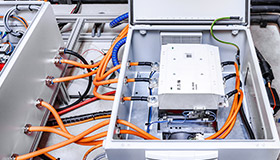
Power protection for measurements under no load during environmental simulation testing
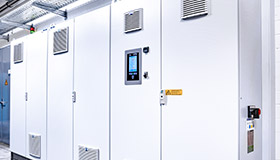
Electric control cabinet for control of temperature and humidity during environmental simulation testing
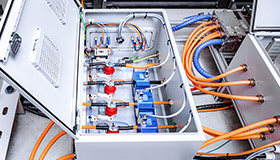
Power measurement technology for hybrid drives to measure power and voltage during environmental simulation testing
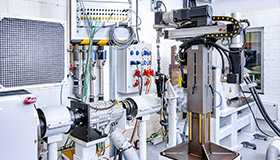
Test bench for electric drive systems for endurance tests during environmental simulation testing
Get into contact
Would you like to know more about the possibilities of our modular, mobile test bench units for environmental simulation? We are looking forward to your call or message!
We are looking forward to your message!
Norms and standards for reliable environmental simulation testing
On our test benches for environmental simulation, ATESTEO offers environmental simulation testing according to customer-specific requirements and testing standards. To test a drivetrain of a vehicle optimally for environmental influences such as humidity, frost, and heat, the environmental simulation test benches are able to work according to the standards DIN EN 60068, ISO 16750, and ISO 19453.
Humidity, sunlight, frost, and rain are only a few examples of environmental influences that components, assemblies, and subassemblies have to be able to withstand during daily use of the vehicle. To test the resilience to these influences, ATESTEO conducts tests on test benches on behalf of the automotive industry and developers of drivetrains and transmissions on electric, electronic, and mechatronic drive components for use in motor vehicles. The following norms and standards apply during testing:
DIN EN 60068 – basic series of standards for testing environmental influences: DIN EN 60068 is about testing the resistance of electric and electronic equipment to expected environmental influences during transport, storage, installation, and under operating conditions during the service life of the equipment. Climatic and mechanical stresses such as temperature, air pressure, shocks, or other influences are taken into account.
ISO 16750 – standard for environmental conditions and testing of electric and electronic devices in road vehicles: ISO 16750 provides guidance on the environmental conditions to which electric and electronic systems in motor vehicles are commonly exposed.
ISO 19453 – test standard for road vehicles for testing under ambient conditions and tests for electric and electronic equipment for drive systems of electric vehicles: ISO 19453 describes the potential environmental while specifying tests and requirements which are recommended for various levels of stress on and in the vehicle. It specifies the requirements for electric drive systems and components with maximum operating voltage.


